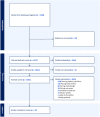Application of machine learning approaches in predicting clinical outcomes in older adults - a systematic review and meta-analysis
- PMID: 37710210
- PMCID: PMC10503191
- DOI: 10.1186/s12877-023-04246-w
Application of machine learning approaches in predicting clinical outcomes in older adults - a systematic review and meta-analysis
Abstract
Background: Machine learning-based prediction models have the potential to have a considerable positive impact on geriatric care.
Design: Systematic review and meta-analyses.
Participants: Older adults (≥ 65 years) in any setting.
Intervention: Machine learning models for predicting clinical outcomes in older adults were evaluated. A random-effects meta-analysis was conducted in two grouped cohorts, where the predictive models were compared based on their performance in predicting mortality i) under and including 6 months ii) over 6 months.
Outcome measures: Studies were grouped into two groups by the clinical outcome, and the models were compared based on the area under the receiver operating characteristic curve metric.
Results: Thirty-seven studies that satisfied the systematic review criteria were appraised, and eight studies predicting a mortality outcome were included in the meta-analyses. We could only pool studies by mortality as there were inconsistent definitions and sparse data to pool studies for other clinical outcomes. The area under the receiver operating characteristic curve from the meta-analysis yielded a summary estimate of 0.80 (95% CI: 0.76 - 0.84) for mortality within 6 months and 0.81 (95% CI: 0.76 - 0.86) for mortality over 6 months, signifying good discriminatory power.
Conclusion: The meta-analysis indicates that machine learning models display good discriminatory power in predicting mortality. However, more large-scale validation studies are necessary. As electronic healthcare databases grow larger and more comprehensive, the available computational power increases and machine learning models become more sophisticated; there should be an effort to integrate these models into a larger research setting to predict various clinical outcomes.
Keywords: Health informatics; Machine learning; Model performance evaluation; Older adults; Predictive modelling; Risk management.
© 2023. BioMed Central Ltd., part of Springer Nature.
Conflict of interest statement
The authors declare no competing interests.
Figures





Similar articles
-
Machine learning models in predicting graft survival in kidney transplantation: meta-analysis.BJS Open. 2023 Mar 7;7(2):zrad011. doi: 10.1093/bjsopen/zrad011. BJS Open. 2023. PMID: 36987687 Free PMC article.
-
A Risk Prediction Model for Physical Restraints Among Older Chinese Adults in Long-term Care Facilities: Machine Learning Study.J Med Internet Res. 2023 Apr 6;25:e43815. doi: 10.2196/43815. J Med Internet Res. 2023. PMID: 37023416 Free PMC article.
-
The future of Cochrane Neonatal.Early Hum Dev. 2020 Nov;150:105191. doi: 10.1016/j.earlhumdev.2020.105191. Epub 2020 Sep 12. Early Hum Dev. 2020. PMID: 33036834
-
Comparative Effectiveness of Machine Learning Approaches for Predicting Gastrointestinal Bleeds in Patients Receiving Antithrombotic Treatment.JAMA Netw Open. 2021 May 3;4(5):e2110703. doi: 10.1001/jamanetworkopen.2021.10703. JAMA Netw Open. 2021. PMID: 34019087 Free PMC article.
-
Does machine learning have a high performance to predict obesity among adults and older adults? A systematic review and meta-analysis.Nutr Metab Cardiovasc Dis. 2024 Sep;34(9):2034-2045. doi: 10.1016/j.numecd.2024.05.020. Epub 2024 May 29. Nutr Metab Cardiovasc Dis. 2024. PMID: 39004592
Cited by
-
Machine learning algorithms for predicting PTSD: a systematic review and meta-analysis.BMC Med Inform Decis Mak. 2025 Jan 21;25(1):34. doi: 10.1186/s12911-024-02754-2. BMC Med Inform Decis Mak. 2025. PMID: 39838346 Free PMC article.
-
Predicting Outcomes in Frail Older Community-Dwellers in Western Australia: Results from the Community Assessment of Risk Screening and Treatment Strategies (CARTS) Programme.Healthcare (Basel). 2024 Jul 5;12(13):1339. doi: 10.3390/healthcare12131339. Healthcare (Basel). 2024. PMID: 38998873 Free PMC article.
-
Drug Burden Index Is a Modifiable Predictor of 30-Day Hospitalization in Community-Dwelling Older Adults With Complex Care Needs: Machine Learning Analysis of InterRAI Data.J Gerontol A Biol Sci Med Sci. 2024 Aug 1;79(8):glae130. doi: 10.1093/gerona/glae130. J Gerontol A Biol Sci Med Sci. 2024. PMID: 38733108 Free PMC article.
-
Application of machine learning in measurement of ageing and geriatric diseases: a systematic review.BMC Geriatr. 2023 Dec 12;23(1):841. doi: 10.1186/s12877-023-04477-x. BMC Geriatr. 2023. PMID: 38087195 Free PMC article.
-
An Introduction to the Artificial Intelligence-Driven Technology Adoption in Nursing Education Conceptual Framework: A Mixed-Methods Study.Nurs Rep. 2025 May 23;15(6):184. doi: 10.3390/nursrep15060184. Nurs Rep. 2025. PMID: 40559475 Free PMC article.
References
-
- Ley C, Martin RK, Pareek A, Groll A, Seil R, Tischer T. Machine learning and conventional statistics: making sense of the differences. Knee Surg Sports Traumatol Arthrosc. 2022;30(3):753–757. - PubMed
Publication types
MeSH terms
LinkOut - more resources
Full Text Sources
Medical
Research Materials

